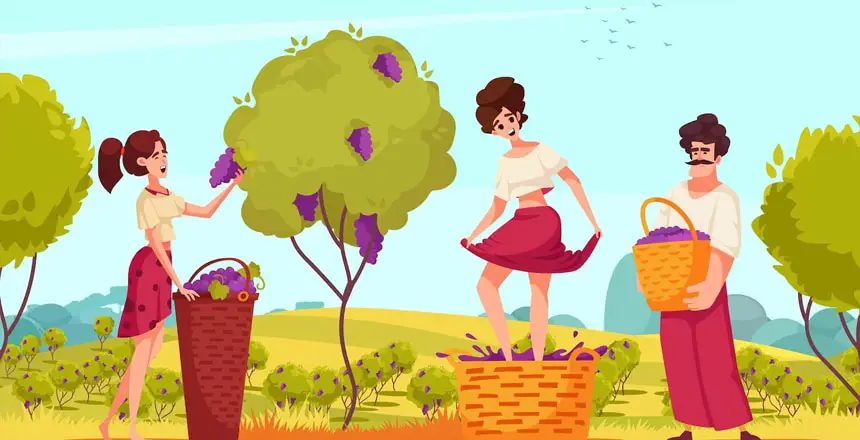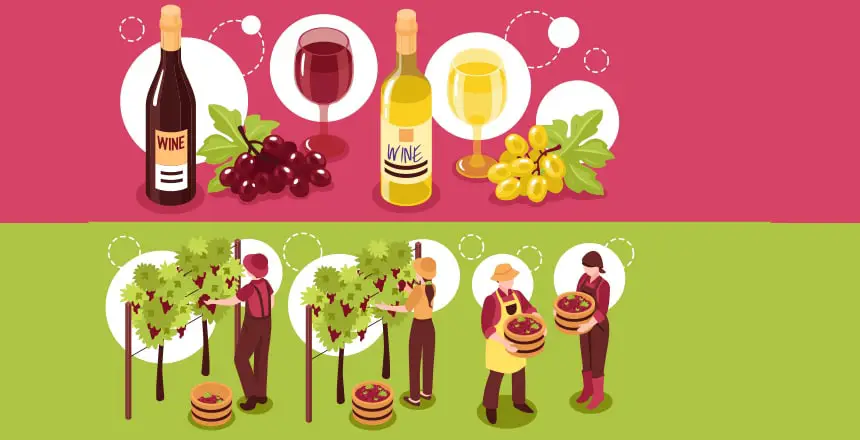Nothing compares to the unique flavor and complexity of homemade wine. Whether you’re an experienced vintner or just embarking on your winemaking journey, making wines from grapes is a truly rewarding experience.
Crafting something delicious out of handpicked fruit provides an unparalleled sense of personal satisfaction. If you’ve ever asked yourself ‘How to make wine from grapes?‘, then this blog post is for you.
Read on to find out how easy it can be to create your own batches at home with only a few simple steps.
Related:
- How Many Glasses in a Wine Bottle
- What is The Difference between White Wine Vinegar and White Vinegar
- What is Sweet White Wine
- How Many Liters Are in a Bottle of Wine
- Does Champagne Go Bad
- What Is Vermouth And What Does It Taste Like
- Champagne Alcohol Content
Contents
When and Where Did Winemaking Begin?

The exact origins of winemaking are unclear, as evidence of winemaking dates back thousands of years and are found in various regions throughout the world.
The history of winemaking dates back to the early days of human civilization. Evidence suggests that winemaking was already a well-established practice in Georgia around 7,000 BC, as archaeologists have uncovered pottery fragments containing traces of tartaric acid – a key component of the wine.
Moreover, ancient civilizations such as the Egyptians, Greeks, and Romans incorporated wine into their religious and cultural practices, with the Romans particularly known for their widespread cultivation of vineyards and the development of winemaking techniques.
In modern times, winemaking is a global industry that has many different techniques and traditions.
How To Choose Grapes to Make Wine?

Grape selection for wine depends on desired flavor and style. Popular red grapes include Merlot, Cabernet Sauvignon, and Pinot Noir. Popular whites include Chardonnay, Sauvignon Blanc, and Riesling.
When choosing grapes to make wine, it’s important to consider climate, soil type, and vineyard exposure. Cooler climates yield more acidic grapes, while warmer climates yield grapes with higher sugar levels.
Finally, take into consideration the potential yield you may get from the grapes, as this will affect how much wine you can produce. It’s important to choose grapes that are ripe and free from disease or damage. Once you’ve chosen your desired grape variety, it’s time to get started on your winemaking journey.
How to Make Wine from Grapes?
Step 1: Ready the Ingredients and Equipment
To make wine from grapes, you’ll need the following ingredients and equipment:
3-5 pounds per gallon of Black Grapes (Wine Grapes)
Ingredients:
- Black Grapes or Wine Grapes
- sugar
- Spices (Cinnamon, Cloves, etc.)
- Yeast
- Wheat
- Pectic Enzyme
Equipment:
- Primary fermentation vessel (such as a food-grade plastic bucket)
- Secondary fermentation vessel (such as a glass carboy)
- Airlock and bung
- Hydrometer
- Wine bottles
- Corks or screw caps
- Bottle corker (if using corks)
Before starting, make sure all equipment is properly sanitized to prevent contamination.
Once you have everything ready, you can move on to the next steps in the winemaking process.
Step 2: Cleaning the Fruits and Containers
The next step in making wine from grapes is to clean both the fruit and the containers to ensure that they are free from any unwanted bacteria or debris.
To clean the grapes, rinse them thoroughly under cool running water and remove any stems, leaves, or other debris.
To clean the fermentation vessel and other equipment, use a solution of sulfite and water or a specialized cleaning agent specifically designed for winemaking equipment.
Proper cleaning is crucial to the success of the winemaking process, as it helps to prevent contamination and ensure that the final product is safe and delicious to drink.
Step 3: Pressing the Grapes
Once the grapes have been cleaned and crushed (if desired), it’s time to press them to extract the juice. This can be done using a grape press or by placing the crushed grapes in a clean cloth or mesh bag and squeezing out the juice by hand.
The juice should be transferred to the primary fermentation vessel and the solid grape remnants, known as must, should be discarded or used for other purposes.
At this point, you may choose to add sugar to the juice to increase the alcohol content of the wine. This step is optional and depends on personal preference.
Once the juice is in the fermentation vessel, it’s time to move on to the next step in the winemaking process.
Step 4: Adding the Ingredients
The next step in making wine from grapes is to add the necessary ingredients to the juice in the fermentation vessel. This typically includes yeast, which is responsible for converting the sugar in the juice into alcohol through the process of fermentation.
Once the ingredients have been added, cover the fermentation vessel with an airlock and bung to allow carbon dioxide to escape while preventing oxygen from entering. Store the vessel in a cool, dark place and allow fermentation to take place for several days to several weeks, depending on the recipe and desired flavor.
During this time, the yeast will consume the sugar in the juice and convert it into alcohol, creating a young wine.
Step 5: Let the Wine Ferment
After adding the necessary ingredients to the juice in the fermentation vessel, it’s important to let the wine ferment for several days to several weeks, depending on the recipe and desired flavor. The initial fermentation process can take anywhere between 15 to 21 days to complete. During this time, the yeast will consume the sugar in the juice and convert it into alcohol, creating a young wine.
It’s important to monitor the fermentation process by checking the specific gravity of the wine using a hydrometer or refractometer. This will allow you to track the progress of fermentation and ensure that it is proceeding as expected.
Once fermentation is complete, the wine will need to be clarified to remove any sediment and achieve a clear, polished appearance.
After clarification, it’s time to age the wine to allow the flavors to develop and mature. This can be done in a variety of ways, such as storing the wine in oak barrels or in bottles in a cool, dark place. The length of aging time will depend on the desired style and flavor of the wine.
Benefits of Making Your Own Wine
Making your own wine has many benefits, and some additional advantages are also worth considering.
For instance, making wine at home allows for complete customization of the final product, including the type of grapes used, the level of sweetness, and the level of alcohol.
Additionally, it can be a cleaner and more environmentally friendly process than purchasing wine from a store, as it eliminates the need for shipping and packaging materials.
Moreover, making wine at home can be a fun and engaging project to take on in the kitchen, providing a sense of accomplishment and pride when the final product is enjoyed.
FAQs
Can You Make Wine From Normal Grapes?
Yes, you can make wine from normal grapes, as long as they are the right type of grapes for winemaking. However, it’s possible to make wine from table grapes, although the resulting wine may not be as high in quality as wine made from wine grapes.
How Long does It Take to Make Wine From Grapes?
During the fermentation process, grape juice is converted into wine by the action of yeast. The fermentation process typically lasts for approximately 2-3 weeks.
Do They Add Alcohol to Grapes to Make Wine?
No, alcohol is not added to grapes to make wine. The alcohol in wine is produced naturally during the fermentation process.
How Much Wine Will 100 Pounds of Grapes Make?
On average, one pound of grapes can yield about one standard 750ml bottle of wine. So, 100 pounds of grapes could produce around 100 bottles of wine or approximately 75 liters of wine.
Should You Wash Grapes Before Crushing Them?
It is important to wash grapes before crushing them to make wine because grapes can be covered in dust, dirt, and other debris.
Conclusion
This process of how to make wine from grapes is complicated yet rewarding and fulfilling. All the steps involved are a delicate balance of factors that come together to give you the final product you desire. With the right knowledge, supplies and patience, it’s possible to learn how to make wine from grapes like a master winemaker.
Now that you have this knowledge on making your own wines, go forth and explore all the possibilities afforded by the grape and what tastes best for your palate.
